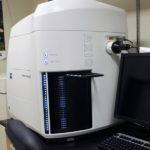Zeiss Axio Scan.Z1 Slide Scanner (Baymax)

-Fixed, sealed slides only (1″x3″ or 2″x3″)
-Objectives: 5x, 10x, 20x
-No lasers.
-Filter cubes for DAPI (FS 49), eGFP (FS 38 HE), Cy 3 (FS 43 HE), mPlum (FS 64 HE), Cy5 (FS 50)
-Software platform: Zen Blue 3.1
- Note: Baymax is a robotic microscope. You must have perfectly clean bottoms and edges of your slides, or the robotic tray handler will get gummed up. Additionally, the tops of your slides’ coverslips must be clean (free of mounting media or nail polish bumps), or the objective lens will get dirty. If your images are blurry, contact MIC staff, as a previous user likely didn’t have clean coverslips. All the objectives in Baymax are air objectives, so they shouldn’t be getting dirty, but the working distance for the 20x objective is quite short. Try to keep your samples towards the middle of your coverslips to prevent the objective from scanning close to the edge of your coverslip where there might be mounting media. Use a kimwipe and solvent to clean your slides before putting them in the slide trays.
STOP! Clean your slides and slide trays
- Before you go for Baymax training, it’s helpful to read ahead and wrap your head around another important concept (besides cleaning your slides). To be successful with an automatic slide scanner, you need to understand that you’ll be programming a *range* of parameters so that Baymax can search for a unique focal plane for tile in each of your samples, on every slide. Have a look at this document. There’s a description of Baymax’s focus-finding algorithm starting on slide 29:
MIC detailed step-by-step cheatsheet for brightfield scanning
- You’ll be a step-ahead if you also look at Zeiss’s new knowledge base videos before you go for Baymax training. Or use these videos to refresh your memory months later:
Zeiss tutorial videos for the Axio Scan.Z1
Stay Puft Training Video
